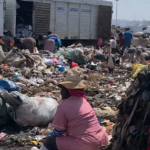By Benard Ogembo
As we enter into the final round of the global plastic treaty negotiations in Busan, South Korea,
questions regarding the mechanism for governing and catalyzing finance remain
contentious. Currently, there are five main considerations whether upstream petrochemical
producers are in scope, the kind of hazardous chemicals to be called out, and whether there will
be product restrictions. The issue of transition is also fraught with member countries still divided
on who will finance the transition, and if the final treaty text will be mandatory or voluntary.
With two weeks of talks on global climate finance scheduled to end on Friday in Baku,
Azerbaijan and many developing countries are left frustrated at what they believed was a lack of
progress in the first week. Poorer countries want at least $1tn a year to help them cut
greenhouse gas emissions and cope with the impacts of extreme weather.
The key aspect of the negotiation of the treaty will be how to pay or resource this economic
transition away from a toxic and problematic linear plastic economy. This is important because for
smaller countries, developing countries, particularly, implementing multilateral agreements can
be incredibly challenging and would want to avoid unfortunate or unnecessary tradeoffs
between what the country is able to do domestically, and having to implement the complete
agreement.
Griffins Ochieng, Executive Director, Centre for Environmental Justice and Development
(CEJAD) says that one of the key obligations agreed upon by the Africa Group of Negotiators in
terms of means of implementation is a new dedicated, predictable, and sustainable adequate
financing, including mandatory contributions from the chemical and petrochemical industry. This is
to prevent and mediate the resulting pollution leakage and legacy pollution.
The scope, as set out by the UNEA Resolution 5/14, requires the adoption of a comprehensive
approach addressing the full life cycle of plastic. However, some countries have expressed
different interpretations of the “full life cycle”, especially about the inclusion of
measures related to plastic polymer production.
According to Jacob Kean Hammerson, a Campaigner at the Environmental Investigation Agency,
the key elements of financial mechanisms that will be discussed under the area of divergence
are what type of fund for the international financial entity would be the key vehicle that delivers this
finance.

Early in the negotiations, proposals for a ‘global plastic fee’ based on the polluter-pays principle
were dismissed. Instead, support was gathered for a more traditional multilateral fund using
developed country donors and managed by an independent body.
Another approach suggested private sector funding managed by an existing organisation, such
as the Global Environment Facility (GEF). Once the mechanism is decided, more questions
arise about the target activities. For example, capacity building, clean-up, behavioral change,
level of implementation both national or international, form of contributions, whether voluntary or
mandatory and funders. This could be public or private sector, developed or developing
countries.
“This comes down to the question; should we rely on something new and tailored for this new
multilateral environmental agreement which is going to take a comprehensive lifecycle
approach?” Hammerson posed.
Existing and recipient countries want something new majorly because they believe that the
financial landscape is not currently working efficiently. This is supported by the United Nations
Environmental Programme (UNEP) review discovered that the current systems lack
coordination and efficiency in delivering the finance, hence the need for something new.
Greenpeace Africa, an Independent Environmental organisation emphasizes the need to
introduce a strong financial mechanism to ensure focused funding to meet the challenges of
solving the plastic pollution crisis. They called upon countries with the most resources and
infrastructure to provide direct financial support for countries with less to transition to innovative
zero-waste economies.
At the moment, the equity markets are valuing the plastic producers as a lower-risk investment
than either the containers and packaging or consumer staples companies in the plastic supply
chain. The implied equity risk premium of the plastic value chain is 5.7%, while the upstream
producers trade on a premium of 4.1%. If the treaty takes a view of the “full life cycle of plastic”
as including polymer production, then the current relative risk discount for producers could be
under threat.
Policymakers warns that the financial markets should watch chemicals of concern with interest
as they could give rise to changes in methods of production and therefore impact operating and
capital expenditure costs, and possibly give rise to significant litigation exposure.
The chemicals and additives used, and emissions originating from plastics production, are a
major contributing factors to plastic pollution, affecting both human health and the environment.
Certainly, some of the major petrochemical exporters are keen to make sure discussions are
focused on downstream waste management rather than production limits. In a push for
circularity, the world may see the phase-out of what the current treaty text terms ‘short-lived and
single-use plastics and intentionally added microplastics’.
For financial institutions, the issue is whether a meaningful drive for circularity affects the
revenues of plastic supply chain companies, as products are withdrawn or substitutes
introduced, and whether sellers of such products are forced to incur extended producer
responsibility (EPR) costs as they are moved upstream, away from the municipalities and their
waste treatment sub-contractors.
According to Richard Kainika, Secretary General, Kenya Association of Waste Recyclers
(KAWR), “Proper implementation of the EPR scheme would mean a good percentage of
expenditure gets back to the waste service providers which can interpret to local jobs,
environment, and the general public health.”
Arianna Manili, Planet Tracker’s Head of Policy says that the negotiators will have to tackle the
tricky issue of financing such a transition. For example, who should pay for what. “The revised
Zero Draft text refers to financial resources which “may include domestic and international
funding, as well as facilitation of private sector financing, including voluntary contributions”. It
also suggests the establishment of a “mechanism for the provision of predictable, sustainable,
adequate, accessible and timely financial resources”, she added.
Arianna also pointed out other financial impacts possible in global trade and would need careful
evaluation, whether that be plastic feedstocks, products, and waste, as well the subsidies and
fiscal incentives for parts of the plastic supply chain. She noted that such subsidies can be
economically very significant.
In 2022, the International Monetary Fund (IMF) reported that fossil fuel subsidies totalled a
record USD 7 trillion, equivalent to 7.1% of global GDP, “about two thirds of what they
governments spend on healthcare.
As Magnus Lovold, an Expert in Diplomacy and International Law puts it, “The rules of
procedure have been a major sticking point, used by a small handful of countries, also referred
to as the ‘like-minded group of countries’ or the ‘low ambition group’. They intend to insist
on a consensus-based approach for voting, therefore allowing a single country veto rather than
permitting a majority-based system. This is not only making decision-making difficult as
contentious issues are sidelined, but it is also consuming valuable negotiating time.”
As the Cop29 summit in Baku, Azerbaijan, nears a close, no resolution has been reached on
the issue of finance. This left country representatives with no option but to explore measures to
ensure circularity in the production processes and waste management, covering such practices
as reuse, refill, repair and repurpose, as well as a possible reduction in production, are
implemented immediately without fail in their respective countries.
This includes what financial institutions should be looking out for – opportunities to partner with
investors and come up with ‘green’ companies can activate a circular economy cross the value.



